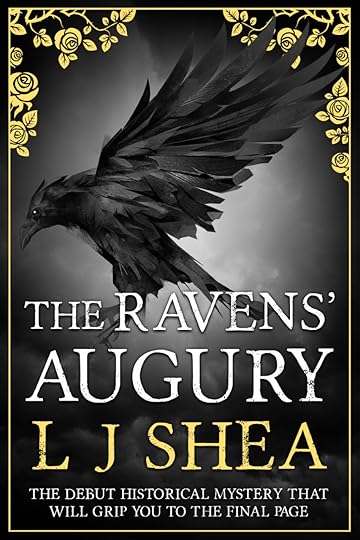L.J. Shea's Blog
October 25, 2019
Sequel update!
I am uploading the first few chapters of the sequel to ‘The Ravens’ Augury’ to WattPad. It is about time! xxx
April 18, 2018
Character Development: the Good, the Bad, and the Ugly
I must confess, I am rather fond of my protagonist, Wat Baudin. When I conjured him up, it was important to me to follow one of the golden rules of mystery writing – the detective must be flawed. And so with this in mind, I decided to make Master Baudin an educated man, and a diligent one, but also a man wracked with self-doubt. This, however, does not impede his success in solving crimes. Wat was easy for me to create, because in many ways he reflects certain facets of my own personality.
But what of my other characters? How did they come about?
The Countess, Lady Joan Ridley, is a no-brainer. She is the archetypal noblewoman of the period. Elegant, cool-headed, poised – and she manages her husband very well from behind the scenes.
Yet characters such as Evelyn, the luckless serving girl, are more difficult to develop. Evelyn is interesting to me in that she is an intelligent female, who by virtue of her low birth has little or no control over her own life. That is, until she takes matters into her own hands…
Creating back stories for my characters is one of my favourite aspects of the writing process. I love getting to know their secrets as the story unfolds. And whether they are good, bad or ugly, to me, they all share one thing in common. They are just like us. They simply do what they must, with the cards that they have been dealt.
And for that very reason, they are dear to me.
December 9, 2017
Challenges of the Etymological Kind
When I am writing, given that my story is set in the 15th century, I often find myself wanting to use words which I am uncertain as to whether or not were in use at that time. Some notable examples include scapegoat, human, and mesmerise. Mesmerise, for example, I was aware would not have been used in Wat Baudin’s world, given that the term was coined in reference to Franz Mesmer, the 18th century German physician who pioneered hypnotism.
So what to do? Googling lists of synonyms is always helpful, but occasionally there are no words to truly replace the ones I would like to use. In “The Ravens’ Augury”, I was extremely particular about this. But this time around, as I currently write its sequel, “The Owl’s Vigil”, I am being a little bit more flexible in my approach to word usage, if it means that I can adequately convey my meaning and the writing is good.
I will just have to remember to write some sort of disclaimer at the beginning!


November 26, 2017
The Process of Becoming Inspired
I must admit that there has been a serious lull in my output of late. Between my sons, my pets, running a household, and even doing a bit of teaching here and there, my writing time seems scant to say the least. And it can be frustrating. Added to this now is the task of attempting to reach a new audience, which means Facebooking, WordPressing, and so on – not my strong suit.
So I find myself in familiar territory. How do I find the time to write?
Honestly, if you are an aspiring writer, I would like to pay homage to the Nike brand here and tell you, “just do it“.
Yesterday, for example, I simply forced myself to sit down with my laptop. I only wrote a page. But it is further along than I was the previous day. And it got me thinking about how to embellish the bare-bones scene I had created. If I keep doing this then eventually, I tell myself, I’ll have a story.
In the meantime, I keep inspired by researching little-known aspects of medieval village life. For example, I recently discovered that when a brew house had a brew ready, they would hang a green branch over their door. From this cool little bit of information, I have created a major theme in the sequel to “The Ravens’ Augury”. I also discovered that women were the ones to do this work. Yet I had already created a major character who is a brewer, and male. What to do? I had to get creative to work my way around this.
This leads me to another part of my story. How do I invent and create characters? Now that is another blog post all of its own! So stay tuned.


October 10, 2017
The Reading of Reviews…
To date, I have but a handful of reviews on my novel’s Amazon page. It’s an interesting thing, to read a review of one’s work, and I admit I have done so with my heart in my mouth! Do people like what I have written? Is it compelling? Does the plot have any major holes that I have missed? These are all questions that race through my mind when I imagine people reading my work. So far, people have been generous with their comments, and this has given me much encouragement to continue with my writing. Constructive criticism is always important to me too, as I strive to hone my creative writing skills. So to all of the people out there who take the time and effort to write reviews once they have finished reading a new book, you are definitely doing something worthwhile.


The reading of reviews…
To date, I have but a handful of reviews on my novel’s Amazon page. It’s an interesting thing, to read a review of one’s work, and I admit I have done so with my heart in my mouth! Do people like what I have written? Is it compelling? Does the plot have any major holes that I have missed? These are all questions that race through my mind when I imagine people reading my work. So far, people have been generous with their comments, and this has given me much encouragement to continue with my writing. Constructive criticism is always important to me too, as I strive to hone my creative writing skills. So to all of the people out there who take the time and effort to write reviews once they have finished reading a new book, you are definitely doing something worthwhile.


October 4, 2017
Horses of the Middle Ages
When I began the research for my medieval mystery novel, The Ravens’ Augury, it was inevitable that companion animals would feature significantly in the storyline. I have loved animals for as long as I can remember.
When I first envisaged Faucher, the imposing yet gentle black horse ridden by the protagonist Wat Baudin, I assumed that he was a Clydesdale. Little did I know at that stage that this breed of horse would not exist for another four hundred years! The name, “Faucher”, is Norman French for ‘to mow.’ Considering how much food the draught horses I have owned can put away, it did seem rather apt. My research indicated that the heavy horses used in medieval times for agricultural purposes were simply called ‘cart horses’ or ‘pack horses’.
Thanks to film and television, I think that most of us picture an immense beast of war when considering what a typical horse looked like during the Middle Ages. These horses were called chargers, or destriers, and it was their role to carry a knight into battle, much like the white steed ridden by the haughty Sir Giles de Tessier in my story. The immense strength and courage required of these horses, to carry a knight in full armour into battle whilst sometimes wearing armour themselves (known as barding), amazes me; my Australian Stock Horse has a melt-down every time I approach her with her winter rug!
The every-day riding horses which Wat’s men, Duncan and Thomas, used were referred to as palfreys, although I did not use this term when I was writing the The Ravens’ Augury, and I was delighted to learn that the very medieval-sounding ‘rouncey’ was an all-rounder horse, used in virtually any capacity.
Another interesting fact which I learned as part of my research into medieval
horsemanship was that, despite the fact that the side saddle had been available for a century by the time the events in my story took place, most women rode astride. I must admit that I had a misconception about this, which is why I felt it important to have Wat’s mother, Elizabeth, riding her mount astride when she is called upon by the countess to come to Rochester Castle.
Writing my first novel allowed me to indulge in plenty of research, and this is one of the many things that I, as a life-long learner, love about the writing process – I am always discovering new things. No matter what you think you know about a certain topic, there is always more to learn.


September 30, 2017
“The Ravens’ Augury”
I am LJ Shea, author of medieval murder mystery, “The Ravens’ Augury”, my debut novel published by Endeavour Press. I will be using this blog to explore the fascinating research component of writing historical fiction, and discussing the writing process itself. I will also be keeping readers up to date with my current work. Welcome!






